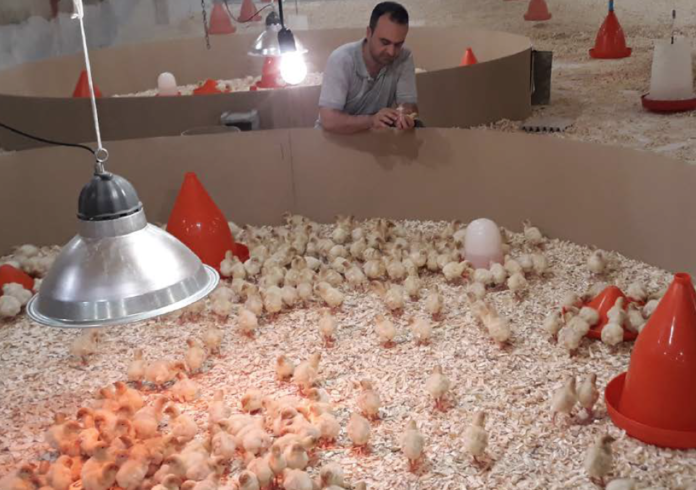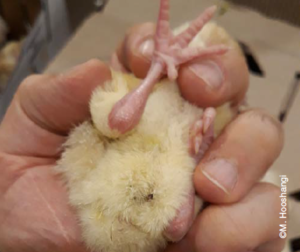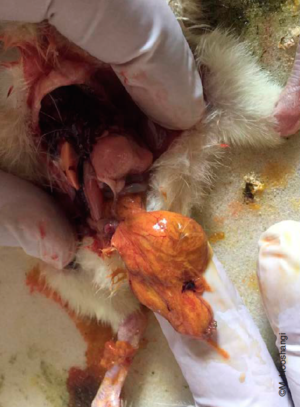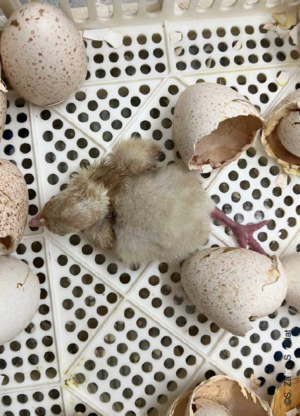
Turkey poults are very sensitive to environmental conditions and any uncomfortable situation very quickly leads to a problem and even sometimes a disaster. Any issues in the early ages, especially in the first week, will impact the genetic potential of the birds, thus the economic efficiency of the cycle.
Dr. Makan Hooshangi (DVM), Veterinarian – Turkey Management Specialist
Mortality and any health issues in the first few days are usually caused by either the breeder farm, hatchery, transportation, the receiving farm or a combination of them. It is obvious that breeder flocks which are not in a good condition will produce weak poults and such poults are more likely to have a high mortality rate in the hatchery and during the first week of brooding. For commercial farms, laboratory testing (M.g., M.s., S.p., etc.) of day-old poults are very important to determine the root cause(s).
 The hatchery-origin causes are mainly due to incorrect incubator settings or hygiene issues. Some of the most common problems in turkey day-old poults are unhealed navel (black button/bruised navel), dehydrated legs (red hocks), and loss of appetite and high mortality in the first week, etc. Poor transportation conditions, including hygiene of the container, careless driving, low or high temperature of the container, etc., can also cause various problems. Nevertheless, some issues are caused by a poor brooding situation. A good receiving condition can even cover the breeder or hatchery-origin problems. In this article, we will give a brief overview of some of these issues.
The hatchery-origin causes are mainly due to incorrect incubator settings or hygiene issues. Some of the most common problems in turkey day-old poults are unhealed navel (black button/bruised navel), dehydrated legs (red hocks), and loss of appetite and high mortality in the first week, etc. Poor transportation conditions, including hygiene of the container, careless driving, low or high temperature of the container, etc., can also cause various problems. Nevertheless, some issues are caused by a poor brooding situation. A good receiving condition can even cover the breeder or hatchery-origin problems. In this article, we will give a brief overview of some of these issues.
Low water consumption
Aside from water quality measures and chlorine levels of the water, one of the most common mistakes in brooding is water temperature. Water that is too warm or too cold is not desirable for the poults and they will drink as much water as they need initially. Therefore, attention must be paid to water temperature. Drinkers should be placed far enough from the heat source so that they do not become too warm. In a brooding ring with a brooder at the center, the best area for the drinkers is around the ring and 30 cm away from the ring surroundings. Note that the best temperature for the drinking water is 10-15 °C, so place the water tank in a suitable place to not let it get very hot in summer, nor too cold in winter.
Fill the drinkers up with water just enough for 6-hour to prevent the water from heating up. Check the drinkers every hour for the first few days. It is common that wood shavings get into the drinkers. Clean them to let the poults to have better access to the clean water. To prevent shavings from getting into the drinkers, you can use special drinkers or simply place a cement mosaic tile under the drinker to raise the drinkers by 2-3 cm above the shavings. This will also make it easier for the poults to drink.
Low feed consumption
High incubation temperatures or low temperatures during the waiting period in the hatchery can cause loss of appetite during the first week. Good brooding management can greatly improve the situation. A warm and soft bedding (usually a 7 cm thick, high-quality wood shaving), the right temperature, a suitable brooder heater, high-quality water and feed, low disturbance after the placement, etc. are among the tasks improve the poults’ situation during the first hours after the placement.
Poor poults that are dehydrated or fatigued are too weak to adapt to the new environment and find the drinkers or feeders. Therefore, it is important to release the poults close to the feeders and drinkers at placement. Using supplements containing electrolytes, glucose, betaine, phosphorus, and B vitamins could significantly improve the situation under such conditions.
Feed temperature is an important factor in poults feed intake. Very cold or very warm feed is not attractive to the poults. Therefore, the feeders should be refilled at certain intervals so that the feed does not remain there and become too warm.
High levels of salt or sodium in feed, poor quality of oil or fat used in feed, moldy feed or ingredients, and some other issues with the feed quality should be considered when troubleshooting low feed intake. When it is too hot or too cold, the poults will not eat. Correcting the temperature (and RH%), taking into account the poults’ behavior and activity, should be the first step. Generally, in all conditions, it is important to find the problem and eliminate the main cause. Then you can use supportive care such as administering B vitamins, feed appetizers, etc.
Remember that feed consumption during the first week is a very important key factor for a successful cycle. However, it is crucial to monitor it carefully from the very first day.
Yolk sac infection
 Although the first thing that comes to mind about yolk sac infection is the hatchery issues, the most common cause is the low temperature during transportation or of the house bedding. It is very important to prewarm the house 48 hours before receiving the poults, especially in cold seasons. A hygienic and warm bedding at poult placement has a great influence in the birds’ welfare and further health situation. Yolk sac infection can cause dramatic damages to the birds. Even the surviving poults would not have a normal growth.
Although the first thing that comes to mind about yolk sac infection is the hatchery issues, the most common cause is the low temperature during transportation or of the house bedding. It is very important to prewarm the house 48 hours before receiving the poults, especially in cold seasons. A hygienic and warm bedding at poult placement has a great influence in the birds’ welfare and further health situation. Yolk sac infection can cause dramatic damages to the birds. Even the surviving poults would not have a normal growth.
Cloaca prolapse
Cloaca prolapse is very common in turkey poults when the feed’s crude fiber level is low especially when wheat or maize gluten meal is used. It usually appears after 72 hours and if not dealt with quickly, many poults will be affected. These poults will stop eating and there will be lots of weak and dehydrated poults which are usually pecked by the others. That is the beginning of a disaster, named cannibalism! It is important to quickly separate the affected poults and keep them in the hospital ring, and correct the feed formula by increasing the CF (crude fiber) level. Meanwhile using B-vitamins, vitamin C, Vitamin A, and probiotics would help quick intestinal recovering.
Cannibalism
In general, cannibalism has been defined as a behavior in poultry when they are stressed by a poor management practice. Turkey poults are inclined to cannibalism. I believe that is because they are very curious and they take in information through their beaks. High light intensity, any nutritional imbalance, high temperature, low humidity, any colored spots on other poults, etc. can encourage turkey poults to start picking and when it becomes a habit, you will be in trouble! Therefore, it is very important to pinpoint and eliminate the underlying cause of the problem as soon as possible.
First, find and solve the causing issue and then try to calm down the flock. Usually, decreasing the light intensity and a two-day administration of Aspirin + Vitamin C should help calm the flock.
Pendulous crop
Although the cause is not well known, it seems that hyperphagia can be a trigger. One of the experienced colleagues, Mr. Georges Le Quentrec (Aviagen Turkeys France), believes that can start in the first week because of the feed’s physical qualities. I have also experienced that the high temperature and low humidity during the first week can start the issue, too. In short, any excessive expansion of the crop can cause this problem because of either overconsuming feed, or drinking too much after a big feed intake.
As many other issues, prevention is the key. Control environmental conditions such as temperature and RH%, fresh and high-quality feed and water should always be provided, and do not forget the risk of aflatoxins in feed!! B vitamins are very important in the digestive system health. I always use vitamin supplements in the first week as the consumption/costs is nothing comparing with the great results.
Splayed legs
 Turkey poults are very prone to leg injuries. Some injuries are physical, such as getting the foot stuck in the grooves of the hatcher’s basket or during the transportation (some because of an unsuitable bedding in the poult box which cannot provide an appropriate leg support during the transportation and some because of careless driving), and others may be due to nutritional deficiencies in the breeder flock. Unfortunately, almost all these injuries are irreversible. What we can do is only preventing the injury in the rest of the flock. Among the measures in this direction, we can mention providing a suitable bedding (soft and warm), prescribing vitamin supplements especially group B vitamins and vitamin D as well as mineral supplements that contain appropriate amounts of calcium, phosphorus, magnesium, zinc, etc. It is obvious, though important to repeat and keep this in mind that a well-balanced feed is crucial and supplements cannot compensate for the nutritional deficiencies.
Turkey poults are very prone to leg injuries. Some injuries are physical, such as getting the foot stuck in the grooves of the hatcher’s basket or during the transportation (some because of an unsuitable bedding in the poult box which cannot provide an appropriate leg support during the transportation and some because of careless driving), and others may be due to nutritional deficiencies in the breeder flock. Unfortunately, almost all these injuries are irreversible. What we can do is only preventing the injury in the rest of the flock. Among the measures in this direction, we can mention providing a suitable bedding (soft and warm), prescribing vitamin supplements especially group B vitamins and vitamin D as well as mineral supplements that contain appropriate amounts of calcium, phosphorus, magnesium, zinc, etc. It is obvious, though important to repeat and keep this in mind that a well-balanced feed is crucial and supplements cannot compensate for the nutritional deficiencies.
Under-target weight
Any issues during the first week such as diseases, low consumption of feed/water, etc. would lead to under-target weight poults. Therefore, it is very important to monitor the initial factors such as feed and water consumption from the beginning and in case of any unpleasant changes look for the cause(s) and try to solve the problem as quickly as possible. However, if you have an under-weight flock at the end of first week, reassure that the causing issue(s) has been solved and try to provide a calm environment and clean, fresh, and appropriate feed and water in clean feeders and drinkers. You may need to shift to the next feed formula a bit later to compensate the low weight gain of the first week.
Turkeys’ size differs dramatically as they grow. Therefore, it is essential to provide drinkers and feeders fit to their size and age. Moreover, the height of drinkers and feeders is very important, something which many farmers ignore. When combined, little points would have great impacts and ignoring them can lead to a big failure.
Non-uniform flock
This usually happens in breeder flocks as a turkey breeder flock may come from different GP flocks with different ages and obviously the size and weight of each group of poults would be different. In this case, if the difference is too much, you can divide the poults at the age of 6 weeks into different weight groups and use higher CP (crude protein) feed for the smaller poults or adding B-complex supplement in their drinking water if possible.
Nonetheless, in commercial farms where you have separated the male and female poults or you have weighed them separately, and the weight uniformity is not good, that means you should reconsider your house management to find the causing problem. Such investigation can range from the physical qualities of the feed or feeders’ performance to the number of poults per feeder or the height of feeders and drinkers.
It also happens when there had been a health issue in the first days such as yolk sac infection of CRD. In this case, I recommend separating the retarded poults and rear them separately. Depending on the severity of the health issue, some poults can recover and some cannot due to damages to the vital organs such as kidneys, or cardiovascular system.

















